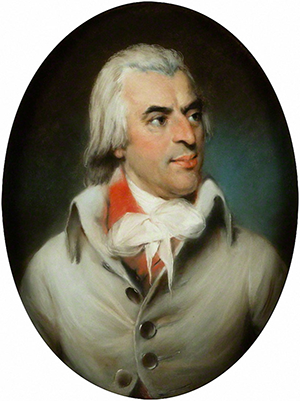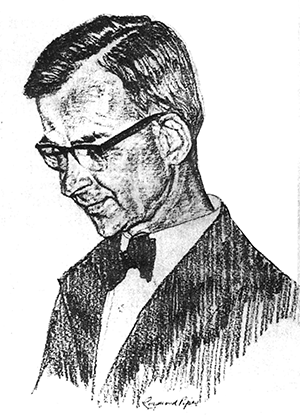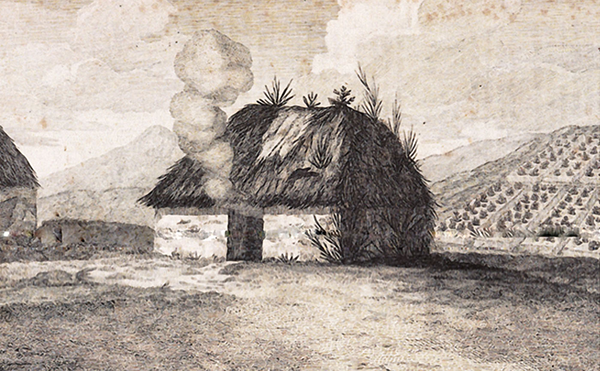A taxing enquiry: how many people were there in pre-census Ireland?
Published in 18th-19th Century Social Perspectives, Features, Issue 3 (May/June 2017), Volume 25Bushe, Connell and an eighteenth-century Irish population controversy.
By David Parker
Gervase Parker Bushe was a taxman. It was his job to ensure that you paid your dues to the Board of Revenue, and that, even if you were ‘on the parish’ and entitled to tax-free status, you—or rather your dwelling, the basis of the important and (to many) onerous two-shilling annual tax per hearth—were at least on record to that effect.
Since arriving at the Board he had effected a revolution in recording properties hitherto ‘suppressed’—those unlisted by tax-collectors, whether out of charity towards poorer households not eligible for formal exemption or as a source of undeclared private income for less scrupulous officers, or because they were too remote to go to the trouble of inspecting them. In 1785 only 474,000 houses had been reported to Ireland’s House of Commons; three years later the tax books contained 621,000, with many still to be added.
It is unclear just what prompted the respected revenue commissioner to undertake a count of Ireland’s population. People weren’t the basis of the hearth-tax: their fireplaces were, and to identify one of those all you needed was a smoking chimney or a more rudimentary outlet. Collectors were assigned ‘walks’—literally an area to be walked, looking for the tell-tale signs of a domestic fire. No chimney might be a bonus: in the absence of evidence of a fixed hearth, a house could be assessed for two—‘an admirable receipt [recipe] for curing poverty’, as Bushe remarked with more than a hint of irony.

Above: Arthur Young—ventured three million in 1778.
A census had been discussed, in Ireland as elsewhere, but often it was considered intrusive or a needless expense. Iceland went ahead regardless in 1703, Denmark in 1769 and the United States in 1790, with Britain and France following in 1801. Ireland had to wait until 1821, after a failed attempt in 1813. Until 1790 the only official tallies available were a 1731 compilation through the Church of Ireland’s parish clergy, showing a dispiriting 2,010,000 inhabitants (admittedly in the wake of three terrible years of hunger and pestilence), and successive estimates based on the hearth-money-collectors’ deficient returns of houses and guesses at the number in each, themselves an improvement on the clergymen’s offering.
Into this partial void spilled a long and occasionally heated controversy from across the Irish Sea. Dr Richard Price believed that England’s population had fallen below five million, while Revd John Howlett concluded that it had risen above six million. Turning their attention to Ireland, Price found a mere 1.9 million in 1767 and Howlett around 2.6 million in 1781, when his adversary’s assumption of 4½ people per recorded house would have yielded 2.15 million. The irrepressible Arthur Young had meanwhile ventured three million in 1778. Numbers were in the air as ‘political arithmetic’ approached the age of modern statistics and demography.
And so in 1788 Bushe sent out a team of 30 of his most trusted and ‘most intelligent’ lieutenants, to ascertain the numbers in sixteen counties in the houses on the Board’s lists. Nothing survives of the doubtless entertaining exchanges with bemused and often suspicious occupants, but the returns came in—thousands of them. Realising that it would take an age to process all the data, the commissioner resolved on sampling the first twentieth of houses in each county for each category: single-hearth, multi-hearthed, new (exempt for the first year after construction on the grounds of probably incomplete occupation) or exempt on the grounds of the occupier’s scant means.
Bigger population than widely assumed
The results were truly an eye-opener, indicating that at 4,040,000 or more the people of Ireland were twice as numerous as was still widely assumed. The sampled counties showed an average of 6.23 occupants per house, to which Bushe added an estimate for 24,800 unlisted properties in thirteen under-reported counties (subsequently raised by him to 40,000, with another 20,000 elsewhere). But such was his desire to avoid inflated or sensational figures that he dismissed as ‘fictitious’ or double-counting later returns showing ten or more per house in the cities of Dublin and Cork, rates which now appear broadly sound.
This was astonishing progress, if his findings could be believed, doubling the church return from 57 years earlier. And not everyone believed it at first. We now know that all the counts of the day fell short of reality, but Bushe’s pioneering effort came closer to the truth than any previous reputable estimate. Sadly, his remarkable project was relegated in the next century and more to being listed as just one of many amid a bewildering variety of mostly far inferior computations from the late seventeenth century to the eve of the census era.
Ireland’s pre-census population remained a fertile field of enquiry and debate, as illustrating an extraordinary growth record for a pre-industrial western society and shedding light on the tragedy of the 1840s. It is now generally accepted that the island’s population more than doubled over the eighteenth century despite episodes of exceptional mortality and net emigration of 1% per decade—this in a period when Europe as a whole added a half, and early industrialising Britain only 65%. And even this performance was surpassed after 1780, when numbers doubled in barely 60 years despite emigration approaching 1½ million.

Above: K.H. Connell—in his The population of Ireland, 1750–1845 (1950) he concluded that Bushe had underestimated the true number of houses but overstated the average number living in each. (Raymond Piper)
Renewed attention to Bushe’s enterprise came with the now 70-year-old reworkings of the cold, heroically unproductive and brilliant K.H. Connell, subsequently incorporated in his classic The population of Ireland. Connell concluded that Bushe had underestimated the true number of houses but overstated the average number living in each. His total for 1788 came out higher: 4.39 million in 777,000 houses, at only 5.65 to each—but even such a shortfall represented a better performance than earlier counts that had missed up to a third of dwellings.
While Connell’s identification of increased fertility as the motor of accelerated growth was widely questioned, his population totals (2.79 million in 1712, rising to 4.75 million by 1791) stood for over 30 years as the standard series—until, that is, David Dickson, Cormac Ó Gráda and Stuart Daultrey proposed significantly lower figures. Their appreciative critique of Connell’s findings rested on three arguments:
- Connell put too much faith in one contemporary’s opinion that half of exempt houses had been uncounted: substituting a more plausible third and omitting unoccupied dwellings reduces his key benchmark 1791 house total by a tenth;
- he erred in assuming a constant undercount of a third throughout 1712–85: omissions were concentrated among exempted dwellings and are instead likely to have accounted for 12–25% of all occupied houses;
- his multiplier for the earlier years was too high: the houses of the tax assessments should be equated with households or families rather than buildings that might contain more than one household, indicating a lower average of nearer five per ‘house’ until the 1750s, rising to 5.8 in 1791.
With these proposed revisions, the authors arrived at a population of 2–2.3 million in 1712, rising to 4.42 million in 1791—a reduction of Connell’s estimates by 0.3–0.8 million across the century and closer to Bushe’s own calculation. This picture of lower numbers and a higher growth rate has replaced Connell’s results in much of the literature.
Connell’s critics were on firm ground in querying his assumed undercount of houses, which, as they pointed out, far exceeded that reckoned by most contemporaries. But their last conclusion rests on far less secure foundations. Far from overstating the number to each house, Connell may have underestimated it, influenced in his choice of multiplier by the early census evidence.
Connell knew of other eighteenth-century estimates of household size well below Bushe’s average. But what decided him in favour of a lower multiplier—5.65 in 1781–91, 5.2–5.56 in earlier years—seems to have been the 1821 census, which indicated an average of 5.95 per occupied house, rising to 6.21 in 1831 with a slight fall to 6.15 in 1841 (not, as Connell thought, to 5.9—a misreading of the figure for all houses which may also have influenced his conclusions). This seeming evidence of rising overcrowding suggested a still lower number in the 1780s.

But it is the 1821 average that is out of line with the other evidence, not that for 1831. It is supported by the incomplete 1813 count, which suggests 5.8 occupants for each of 1.02 million dwellings but is itself generally considered deficient. Nor is the 1821 record unequivocal: in terms of families per house, it is the most ‘overcrowded’ of the three completed pre-Famine enumerations. This could be the consequence of a difference in definition, with the family (here a mere 5.2 individuals against 5.6 in the two subsequent counts) on this occasion being more narrowly interpreted, but the same may also be true of the housing unit.
Back to Bushe
Here it is important to recall who Bushe’s investigators were: they were considered by him the best of the very tax-collectors and overseers who had supplied the numbers of houses in the first place. Their returns were based on what they had already counted as a house, the very unit on which our later estimates rely. It seems odd to adopt the revenue officers’ assessment unit as the foundation for our calculations and then to attach to it an average occupancy rate for something else, whether the economically self-contained household or the narrower cohabiting family defined by kinship.

Above: No chimney might be a bonus: in the absence of evidence of a fixed hearth, a house could be assessed at two—‘an admirable receipt [recipe] for curing poverty’, according to Bushe. (Arthur Young, A tour of Ireland, 1776–78)
A final argument in favour of the 1788 count is its own internal consistency. All but one of the county averages reported by Bushe’s lieutenants fall in the 5.9–6.5 range, with the sole apparent outlier—Kilkenny—seemingly the result of a tabulation error. Had any of his subordinates provided faulty returns, we might expect to see evidence in the form of wider variation for individual areas. Supplementary figures received in the next two years for additional counties showed a similar average, most averaging six and urban areas more.
Bushe’s count was thus not a representative sample of all dwellings but a survey of those contained in the hearth-tax books, from which many poorer properties are thought to have been left out. It follows that, in general, unlisted homes were humbler than the average abode. By 1788 unrecorded houses numbered perhaps a seventh of all dwellings, a great improvement on the situation a few years earlier. Bushe confessed to being unable to ‘speak with confidence’ of the likely number of occupants of those remaining to be listed, but his brief summary offers an indication in the form of a tabulation for Wexford, where properties exempted on grounds of poverty averaged only four-fifths as many inhabitants as all houses.
Adjusting the corrected returns for the sixteen unsampled counties (whose houses averaged rather more occupants in 1821, as might be expected from their inclusion of the two leading cities) and assuming a generous average of five occupants for the properties still to be recorded (many of them thought to be widows’ dwellings, presumably containing fewer still, but not all exempt) brings Bushe’s average down to 6.1, eliminating nearly half of the excess over the 1821 figure. Though still higher than the result indicated by the first full census, the adjusted rate is below those for 1831 and 1841, as we might expect, given the high natural growth of the intervening decades and what we might assume to be a larger family size.
Coupling Dickson et al.’s well-reasoned estimate of 757,380 occupied houses in 1791 with the adjusted multiplier yields a population of 4.62 million, appreciably above their 4.42 million (by this reckoning instead the total in 1788) but below Connell’s 4.75 million (though very close to his more realistic 4.59 million for 1790). This implies natural growth averaging just over 1½% annually to the early census period, with numbers rising (after allowance for emigration) to 5.2 million in 1800, 6.2 million in 1813 (some 250,000 more than the official correction for the latter year’s failed census) and 6.9 million in 1821, this time 100,000 more than the census count.
What of earlier population numbers? Here it seems probable that population and recorded houses moved broadly in unison, as untaxed dwellings are likely to have been more numerous just when the number of occupants in each was at a low, householders being informally excused—or collectors more readily bought off—in the aftermath of mortality crises when in a longer period of generally low prices more qualified also for official exemption. Connell’s results before the 1750s indicate around eight people in the whole country per recorded house, Dickson’s an unrealistically low 5½–6½. Plausible numbers for later decades suggest a mid-century population of around three million and a pre-crisis ratio near 7½, yielding 2.9 million in 1725, 2.6 million in 1712 and 2.4 million at the start of the century. Even allowing for an exceptional undercount of houses in 1749, the two decades after 1726 stand out as a time over which numbers barely grew, as hundreds of thousands fell victim to hunger and disease.
Conclusion
In the absence of conclusive data even into the census period, the jury is still out on Connell’s conviction that increased fertility was the principal source of quickened growth, while the deterioration of the house returns in 1760–85 makes his identification of a demographic take-off from the 1770s difficult to substantiate, a significant part of the increase in the 1750s and 1760s having possibly gone unrecorded. Comparing the relatively untroubled opening quarters of the eighteenth and nineteenth centuries, rather more than half of the intervening doubling of natural growth may be attributable to the rise in the crude birth rate, but the unknowns for the earlier period are too great to inspire much confidence either way. It is probable that changes in fertility and mortality each contributed crucially to Ireland’s exceptional population surge in the century after 1746.
Connell’s findings—inspired in part by Bushe’s work—remain of immense value, though some of his assumptions now appear flawed. Dickson, Ó Gráda and Daultrey brought forth an additional wealth of data and analysis incorporating ground-breaking insight into regional trends, though their superimposition on the tax-collectors’ assessment unit of an average for a different household concept caused their aggregates to err on the low side. But it is Bushe’s remarkable survey that above all merits rehabilitation and further study for the light it throws on the pre-census performance of a population unique in its demographic characteristics.
David Parker is a librarian and independent researcher.
FURTHER READING
G.P. Bushe, ‘An essay towards ascertaining the population of Ireland’, Transactions of the Royal Irish Academy 3 (1790).
[Census of Ireland, 1821] Abstract of the answers and returns … (London, 1823).
K.H. Connell, The population of Ireland, 1750–1845 (Oxford, 1950).
D. Dickson, C. Ó Gráda & S. Daultrey, ‘Hearth tax, household size and Irish population change 1672–1821’, Proceedings of the Royal Irish Academy 82C (1982), 125–81.
















